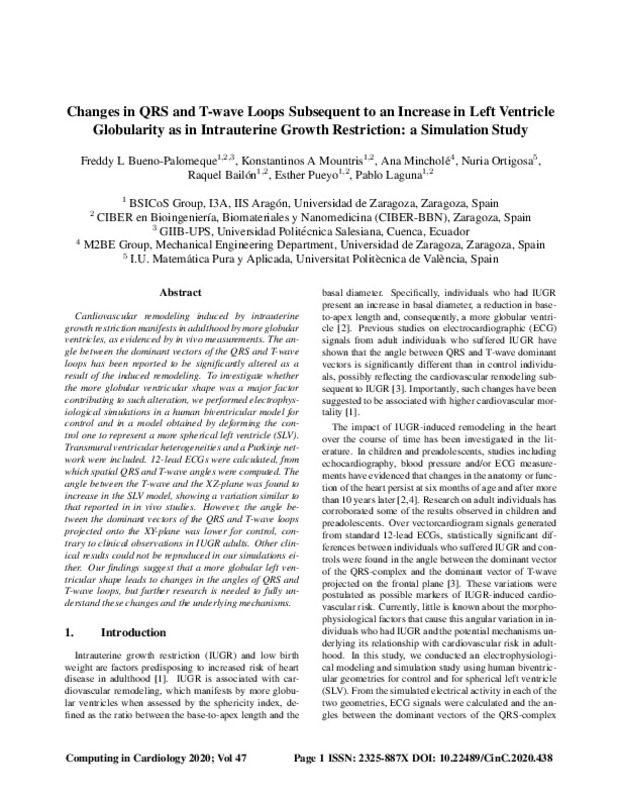JavaScript is disabled for your browser. Some features of this site may not work without it.
Buscar en RiuNet
Listar
Mi cuenta
Estadísticas
Ayuda RiuNet
Admin. UPV
Changes in QRS and T-wave Loops Subsequent to an Increase in Left Ventricle Globularity as in Intrauterine Growth Restriction: a Simulation Study
Mostrar el registro sencillo del ítem
Ficheros en el ítem
| dc.contributor.author | Bueno-Palomeque, Freddy L
|
es_ES |
| dc.contributor.author | Mountris, Konstantinos A
|
es_ES |
| dc.contributor.author | Mincholé, Ana
|
es_ES |
| dc.contributor.author | Ortigosa, Nuria
|
es_ES |
| dc.contributor.author | Bailón, Raquel
|
es_ES |
| dc.contributor.author | Pueyo, Esther
|
es_ES |
| dc.contributor.author | Laguna, Pablo
|
es_ES |
| dc.date.accessioned | 2021-12-27T08:37:23Z | |
| dc.date.available | 2021-12-27T08:37:23Z | |
| dc.date.issued | 2020-09-16 | es_ES |
| dc.identifier.issn | 2325-887X | es_ES |
| dc.identifier.uri | http://hdl.handle.net/10251/178908 | |
| dc.description.abstract | [EN] Cardiovascular remodeling induced by intrauterine growth restriction manifests in adulthood by more globular ventricles, as evidenced by in vivo measurements. The angle between the dominant vectors of the QRS and T-wave loops has been reported to be significantly altered as a result of the induced remodeling. To investigate whether the more globular ventricular shape was a major factor contributing to such alteration, we performed electrophysiological simulations in a human biventricular model for control and in a model obtained by deforming the control one to represent a more spherical left ventricle (SLV). Transmural ventricular heterogeneities and a Purkinje network were included. 12-lead ECGs were calculated, from which spatial QRS and T-wave angles were computed. The angle between the T-wave and the XZ-plane was found to increase in the SLV model, showing a variation similar to that reported in in vivo studies. However, the angle between the dominant vectors of the QRS and T-wave loops projected onto the XY-plane was lower for control, contrary to clinical observations in IUGR adults. Other clinical results could not be reproduced in our simulations either. Our findings suggest that a more globular left ventricular shape leads to changes in the angles of QRS and T-wave loops, but further research is needed to fully understand these changes and the underlying mechanisms | es_ES |
| dc.description.sponsorship | I would like to acknowledge support by Fundaci ' on Carolina, Universidad de Zaragoza and Universidad Polit ' ecnica Salesiana through its doctoral scholar-ship. This work was supported by projects ERC-StG 638284 (ERC), PID2019-105674RB-I00 and PID2019104881RB-I00 (MICINN) and LMP124-18 and reference group T39-20R (Arag ' on Government cofunded by FEDER 2014-2020 "Building Europe from Aragon"). Computations were performed using ICTS NANBIOSIS (HPC unit at U. Zaragoza). N. Ortigosa acknowledges support from Generalitat Valenciana under grant Prometeo/2017/102 and Spanish MINECO under grant MTM2016-76647-P | es_ES |
| dc.language | Inglés | es_ES |
| dc.publisher | IEEE | es_ES |
| dc.relation.ispartof | CinC 2020. Computing in Cardiology, vol. 47 | es_ES |
| dc.rights | Reconocimiento (by) | es_ES |
| dc.subject.classification | MATEMATICA APLICADA | es_ES |
| dc.title | Changes in QRS and T-wave Loops Subsequent to an Increase in Left Ventricle Globularity as in Intrauterine Growth Restriction: a Simulation Study | es_ES |
| dc.type | Comunicación en congreso | es_ES |
| dc.type | Artículo | es_ES |
| dc.identifier.doi | 10.22489/CinC.2020.438 | es_ES |
| dc.relation.projectID | info:eu-repo/grantAgreement/AEI/Plan Estatal de Investigación Científica y Técnica y de Innovación 2017-2020/PID2019-104881RB-I00/ES/ANALISIS DE SEÑAL BASADO EN LA FISIOLOGIA PARA EL GUIADO DEL MANEJO Y TERAPIA DE ARRITMIAS CARDIACAS/ | es_ES |
| dc.relation.projectID | info:eu-repo/grantAgreement/Gobierno de Aragón//BSICoS T39-20R/ | es_ES |
| dc.relation.projectID | info:eu-repo/grantAgreement/AEI/Plan Estatal de Investigación Científica y Técnica y de Innovación 2017-2020/PID2019-105674RB-I00/ES/TOWARDS IMPROVED MANAGEMENT OF CARDIOVASCULAR DISEASES BY INTEGRATIVE IN SILICO-IN VITRO-IN VIVO RESEARCH INTO HEART'S STRUCTURE, FUNCTION AND AUTONOMIC REGULATION/ | es_ES |
| dc.relation.projectID | info:eu-repo/grantAgreement/DGA//LMP124-18/ | es_ES |
| dc.relation.projectID | info:eu-repo/grantAgreement/EC/H2020/638284/EU/Is your heart aging well? A systems biology approach to characterize cardiac aging from the cell to the body surface/MODELAGE | es_ES |
| dc.relation.projectID | info:eu-repo/grantAgreement/AEI//MTM2016-76647-P/ES/ANALISIS FUNCIONAL, TEORIA DE OPERADORES Y ANALISIS TIEMPO-FRECUENCIA/ | es_ES |
| dc.relation.projectID | info:eu-repo/grantAgreement/GVA//PROMETEO%2F2017%2F102/ES/ANALISIS FUNCIONAL, TEORIA DE OPERADORES Y APLICACIONES./ | es_ES |
| dc.rights.accessRights | Abierto | es_ES |
| dc.contributor.affiliation | Universitat Politècnica de València. Departamento de Matemática Aplicada - Departament de Matemàtica Aplicada | es_ES |
| dc.description.bibliographicCitation | Bueno-Palomeque, FL.; Mountris, KA.; Mincholé, A.; Ortigosa, N.; Bailón, R.; Pueyo, E.; Laguna, P. (2020). Changes in QRS and T-wave Loops Subsequent to an Increase in Left Ventricle Globularity as in Intrauterine Growth Restriction: a Simulation Study. IEEE. 1-4. https://doi.org/10.22489/CinC.2020.438 | es_ES |
| dc.description.accrualMethod | S | es_ES |
| dc.relation.conferencename | 47th Computing in Cardiology Conference (CinC 2020) | es_ES |
| dc.relation.conferencedate | Septiembre 13-16,2020 | es_ES |
| dc.relation.conferenceplace | Rimini, Italia | es_ES |
| dc.relation.publisherversion | https://doi.org/10.22489/CinC.2020.438 | es_ES |
| dc.description.upvformatpinicio | 1 | es_ES |
| dc.description.upvformatpfin | 4 | es_ES |
| dc.type.version | info:eu-repo/semantics/publishedVersion | es_ES |
| dc.relation.pasarela | S\429550 | es_ES |
| dc.contributor.funder | European Commission | es_ES |
| dc.contributor.funder | Gobierno de Aragón | es_ES |
| dc.contributor.funder | Diputación General de Aragón | es_ES |
| dc.contributor.funder | Agencia Estatal de Investigación | es_ES |








